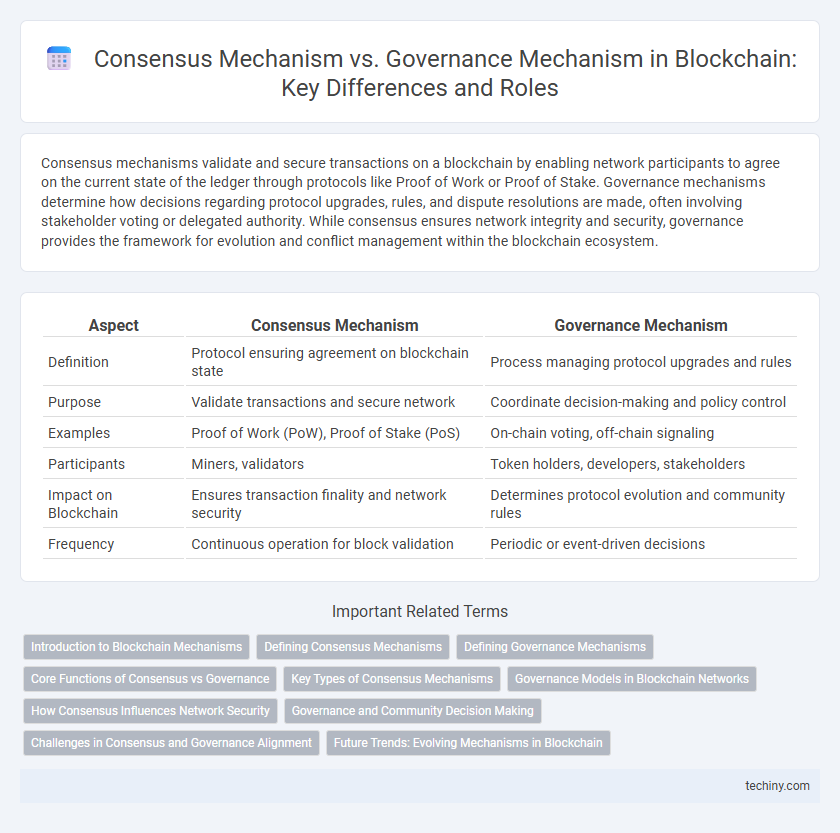Consensus mechanisms validate and secure transactions on a blockchain by enabling network participants to agree on the current state of the ledger through protocols like Proof of Work or Proof of Stake. Governance mechanisms determine how decisions regarding protocol upgrades, rules, and dispute resolutions are made, often involving stakeholder voting or delegated authority. While consensus ensures network integrity and security, governance provides the framework for evolution and conflict management within the blockchain ecosystem.
Table of Comparison
| Aspect | Consensus Mechanism | Governance Mechanism |
|---|---|---|
| Definition | Protocol ensuring agreement on blockchain state | Process managing protocol upgrades and rules |
| Purpose | Validate transactions and secure network | Coordinate decision-making and policy control |
| Examples | Proof of Work (PoW), Proof of Stake (PoS) | On-chain voting, off-chain signaling |
| Participants | Miners, validators | Token holders, developers, stakeholders |
| Impact on Blockchain | Ensures transaction finality and network security | Determines protocol evolution and community rules |
| Frequency | Continuous operation for block validation | Periodic or event-driven decisions |
Introduction to Blockchain Mechanisms
Consensus mechanisms in blockchain technology ensure agreement on the network's state by validating and recording transactions through protocols like Proof of Work (PoW) and Proof of Stake (PoS). Governance mechanisms define the rules and decision-making processes that coordinate protocol upgrades, dispute resolution, and network participation. Both mechanisms are essential for maintaining decentralization, security, and the continuous evolution of blockchain ecosystems.
Defining Consensus Mechanisms
Consensus mechanisms are foundational protocols in blockchain technology that ensure all network participants agree on a single version of the truth, enabling secure and decentralized transaction validation. Proof of Work (PoW), Proof of Stake (PoS), and Delegated Proof of Stake (DPoS) exemplify diverse consensus algorithms, each optimizing for security, scalability, or energy efficiency. These mechanisms establish trust among nodes by preventing double-spending and achieving data immutability without centralized control.
Defining Governance Mechanisms
Governance mechanisms in blockchain define the rules and processes through which stakeholders participate in decision-making and protocol upgrades, ensuring network adaptability and stakeholder alignment. Unlike consensus mechanisms, which validate transactions and maintain ledger integrity, governance mechanisms address conflicts and strategic changes by involving token holders, developers, and validators. Effective governance systems leverage on-chain voting, delegation, and proposal frameworks to balance decentralization, transparency, and scalability.
Core Functions of Consensus vs Governance
Consensus mechanisms establish agreement on the blockchain's transaction history, ensuring data integrity and security through protocols like Proof of Work or Proof of Stake. Governance mechanisms define decision-making processes for protocol upgrades, parameter changes, and dispute resolution, enabling decentralized control and community participation. While consensus secures the network at a technical level, governance manages its evolution and operational policies.
Key Types of Consensus Mechanisms
Key types of consensus mechanisms in blockchain include Proof of Work (PoW), Proof of Stake (PoS), and Delegated Proof of Stake (DPoS), each providing distinct methods for validating transactions and securing the network. PoW relies on computational power to solve cryptographic puzzles, while PoS selects validators based on their stake in the network, enhancing energy efficiency. DPoS introduces a voting system where stakeholders elect delegates to validate transactions, improving scalability and governance participation.
Governance Models in Blockchain Networks
Governance models in blockchain networks define the decision-making processes that guide protocol upgrades, dispute resolution, and resource allocation within decentralized systems. These models range from on-chain governance, where protocol rules are modified through stakeholder voting encoded in smart contracts, to off-chain governance involving informal discussions and consensus among developers and community members. Effective governance models ensure transparency, inclusivity, and adaptability, enabling blockchain networks to evolve while maintaining security and decentralization.
How Consensus Influences Network Security
Consensus mechanisms such as Proof of Work (PoW) and Proof of Stake (PoS) play a critical role in securing blockchain networks by ensuring agreement on transaction validity among decentralized nodes. These mechanisms prevent double-spending and resist attacks like 51% attacks by requiring substantial computational or stake-based investment, thus enhancing network security. Governance mechanisms, while essential for protocol upgrades and dispute resolution, have a more indirect impact on security compared to the immediate effect of consensus protocols in maintaining network integrity.
Governance and Community Decision Making
Governance mechanisms in blockchain provide structured frameworks for community decision-making, enabling stakeholders to influence protocol upgrades, funding allocations, and rule changes. Unlike consensus mechanisms that secure transaction validation, governance leverages voting systems and proposals to ensure decentralized control and adaptability of the network. Effective blockchain governance fosters transparency, inclusivity, and long-term sustainability by aligning community interests with protocol development.
Challenges in Consensus and Governance Alignment
Consensus mechanisms in blockchain face challenges such as scalability limitations and energy inefficiency, which directly impact transaction speed and network security. Governance mechanisms struggle with aligning stakeholder interests and ensuring transparent, inclusive decision-making processes, often leading to centralization risks. Balancing these dual aspects requires advanced frameworks that integrate robust consensus protocols with adaptive governance models to maintain network integrity and user trust.
Future Trends: Evolving Mechanisms in Blockchain
Future trends in blockchain reveal a convergence between consensus mechanisms and governance models to enhance scalability, security, and decentralization. Emerging protocols emphasize adaptive consensus algorithms like Proof of Stake (PoS) combined with on-chain governance frameworks, enabling dynamic decision-making and protocol upgrades without network forks. This evolution drives the development of hybrid systems integrating decentralized autonomous organizations (DAOs) for more transparent and participatory blockchain ecosystems.
Consensus Mechanism vs Governance Mechanism Infographic

 techiny.com
techiny.com